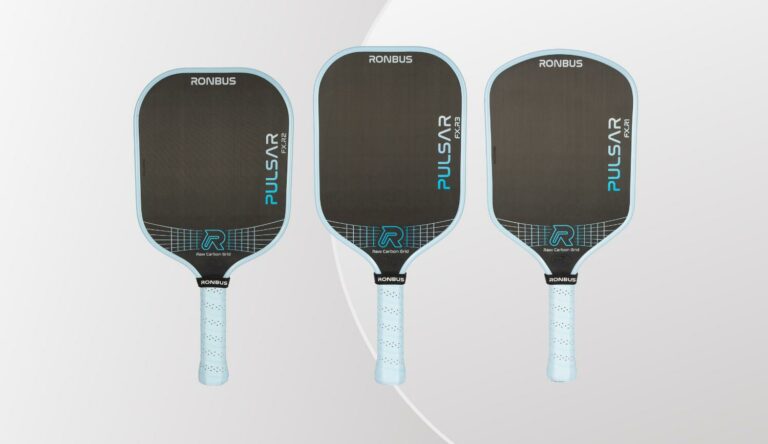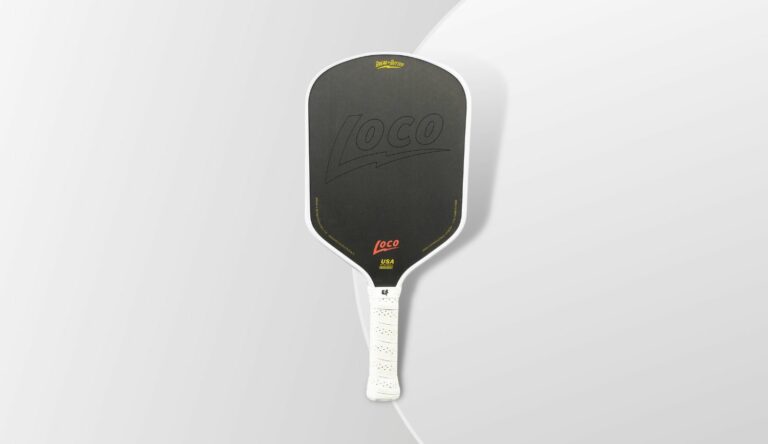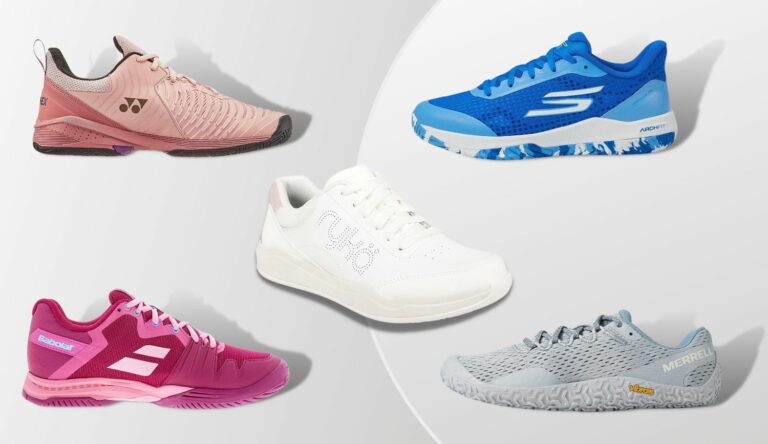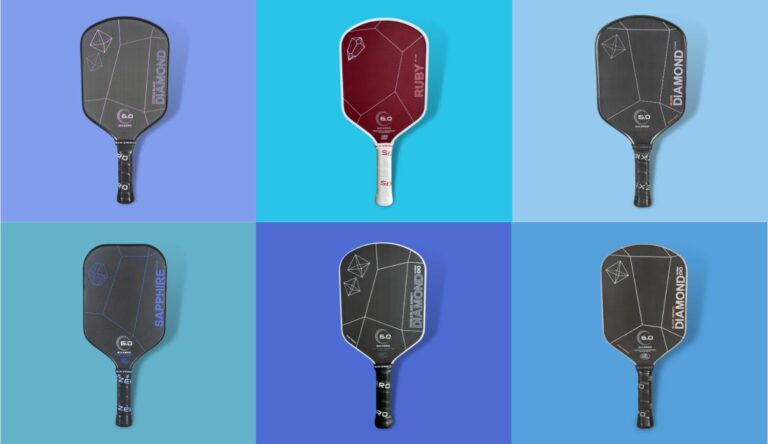Pickleball is the fastest-growing sport in the country. There are new players picking up paddles and hitting the courts every day.
Whether you’re brand new to pickleball or got your start recently, the following tips will help you solidify your understanding of the game and provide you with strategies you’ll need to move to the intermediate level.
This post is part of a tips series that includes:
- Beginner tips
- Intermediate tips
- Advanced tips
- Worst tips (to avoid)
Alright, let’s dive into the beginner’s tips!
Contents
- 1. Familiarize yourself with the basic rules of pickleball
- 2. Establish an effective ready position
- 3. Keep your movements centered and your swings compact
- 4. Take your time to square up before hitting the ball
- 5. Shift to cover the court
- 6. Serve and return the ball deep
- 7. Stay back after you serve
- 8. Prioritize keeping the ball in play
1. Familiarize yourself with the basic rules of pickleball
Pickleball becomes a lot more enjoyable once you have a firm grasp of the ins and outs of the rulebook. You don’t have to nerd out and know every little detail, but you want a solid grasp on the important stuff.
This includes the serve rules, the two-bounce rule, the NVZ/kitchen rules, etc.
I have a dedicated post on pickleball rules that can help you dial in your understanding of the essential stuff.
2. Establish an effective ready position
To level up in pickleball, you’ll want to adopt a strong ready position as soon as possible. I can usually tell whether a new player has potential or has had coaching simply by how they stand in their ready position.
Here are some ready position tips:
- Keep your paddle high and near your chest. This helps you react quicker, especially at the net.
- Keep your stance low and ready to spring. When preparing for the ball to come your way, you want to be slightly crouched with a wide-set base like you’re ready to pounce. You don’t have to be bending in an overly exaggerated way, or anything. You just do not want to be standing idly like you’re waiting for a bus. When you get low with bend knees, you’re more readily able to be explosive and get below the ball for dinks and to dig out hard low shots.
- Vary your paddle position depending on your court position. When you’re up at the kitchen, you want to have your paddle up and ready to block or attack the ball. When you’re stepped back from the kitchen line, it’s better to have your paddle lower, in case your opponent tries to target your feet. If they hit fast and high at you, you should be able to react in time. If not, chances are that the ball’s trajectory is too high and will be going out anyway.
- Stay consistent. Skilled players will not lapse in maintaining their ready position. You always want to have your paddle up and ready between each shot when at the kitchen line. The moment you drop your positioning is the moment when your opponent targets you with a speed-up.
3. Keep your movements centered and your swings compact
One of the mistakes beginner pickleball players make on the court is swinging wildly and not having a solid center of balance.
In pickleball, you want to move like an athlete. Here are some essential tips:
- Focus on developing proper footwork while maintaining a low and wide stance. Avoid resting your weight on the balls of your feet. Instead, stay on your toes when prepping for an incoming ball. This will help you explode side to side and forward/backward.
- Keep your head and torso movements minimal. When moving about the court, you want to remain as stable and fluid as possible. Controlling your momentum like this is easiest when your torso is relatively still and your legs are doing most of the work. If you flail around while moving, you’re far more likely to get unbalanced and mishit the ball. You’re also going to be less prepared for the next shot that comes your way.
- Only move as much as necessary when swinging at the ball. A lot of beginning pickleballers will swing in a very exaggerated fashion with huge follow-throughs. While this can be okay when you’re hitting a big groundstroke near the back of the court at the baseline, it’s not something you want to do closer up at the net. When at the kitchen line, you’ll want to hit the ball with tight, compact swings. This will help you keep a solid ready position for the next shot.
4. Take your time to square up before hitting the ball
Beginner players often feel pressured to hit the ball as fast as possible and don’t take advantage of the time they have to properly set their feet and prepare hot hit a fundamentally sound shot.
But, unlike other paddle sports like tennis and racquetball, you’ll typically have a decent amount of time to prepare to hit an incoming shot in pickleball.
Try to be aware of the time that’s available to you and avoid feeling rushed or pressured unnecessarily. You’ll typically have more time than you think, and you’ll be able to leverage that time to get into the best positioning possible.
5. Shift to cover the court
As a beginner, it’s important that you develop an understanding of proper court coverage. You obviously do not want to crowd your partner and disrupt their shot, but the more subtle court positioning is around closing gaps.
The official term for shifting to cover open gaps is “shading”. It refers to how players shift side to side throughout the point depending on where the ball is moving.
Shading can get somewhat complicated, but the basics are that you want to follow the ball and be in front of it. If the ball gets hit to the left side of the court, you and your partner are going to want to shift over to that side to cover the next shot.
Moving like this gives you the best opportunity to cover any advantageous angles that your opponent could take, primarily the shot right down the outside line or one placed in the middle between you and your partner. Closing those gaps will keep you in the point.
6. Serve and return the ball deep
One of the main positioning advantages in pickleball is being up at the kitchen/NVZ line. You want to make your way up to the kitchen line in every point, and by the same token, want to keep your opponent as far back as possible.
Since the serve and return in both need to bounce before they can be hit in pickleball, hitting a deep shot to the back of the court ensures that your opponent will have to stay back to hit the ball off of the bounce.
Not only does it keep them back, but it creates a situation where their shot is more difficult. This is especially true when you hit a deep return, because you are able to move to the kitchen line, while your opponent has to stay far back to hit your deep return. This makes their 3rd shot, one of the most challenging and important shots in pickleball, that much harder.
7. Stay back after you serve
Remember, the return has to bounce. So if you’ve hit a serve and the returning team is hitting their return back at you, you’ll need to let it bounce.
A lot of beginner pickleball players forget this and take steps into the court after hitting their serve. Typically, opponents will realize this and hit a deep return right to them, which they won’t be prepared for. Usually, this results in the server hitting the ball before it bounces (losing the point), popping it up, or hitting it out of bounces.
So, be sure to stay back after you’ve served. This way, you won’t have to react by backpedaling in an attempt to get behind a deeply-returned ball.
8. Prioritize keeping the ball in play
Most rallies in pickleball are decided by unforced errors. This is especially true of games with new players, where out-of-control and high-risk shots dominate.
To advance, focus on keeping the ball in play. You want to let your opponent be the one to make the mistakes, not you.
To do this well, don’t try to hit everything hard or go for too many low-percentage shots (i.e difficult sideline shots or untimely speedups). FOcus on placement more than power, and control over pace.
Above all, be patient. A lot of players will get antsy in long rallies and try to make the winning kill shot to finish things off. Unless there’s a great opportunity to hit a winner, you’re most likely just going to end up losing the point with this strategy.
Keep reading:
- 10 essential pickleball rules
- Best Beginner pickleball paddles
- Pickleball Skill Ratings 101
- Best Pickleball Paddles for $100 or Less
- How to Win Against Hard-Hitting Bangers






